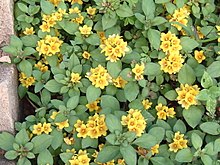| Lysimachia congestiflora | |
|---|---|
 | |
| Scientific classification | |
| Kingdom: | Plantae |
| Clade: | Tracheophytes |
| Clade: | Angiosperms |
| Clade: | Eudicots |
| Clade: | Asterids |
| Order: | Ericales |
| Family: | Primulaceae |
| Genus: | Lysimachia |
| Species: | L. congestiflora |
| Binomial name | |
| Lysimachia congestiflora | |
| Synonyms [1] | |
| |
Lysimachia congestiflora, known as golden globes loosestrife or creeping Jenny, [a] is a species of flowering plant in the primrose family Primulaceae . [1] [2] It is native to southeast Asia.

